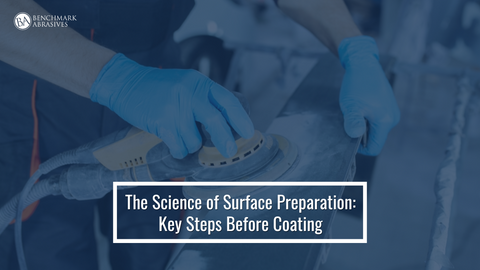
The Science Of Surface Preparation: Key Steps Before Coating

The term "surface preparation" describes the range of techniques that can be used to prepare a material's surface to prepare it for coating application, adhesive use, and other processes. Surface preparation is necessary before painting, coating, or lining steel or other substrates.
Surface preparation can be carried out chemically or physically to remove previous coatings, residue, surface flaws, organic debris, oxidation, and other impurities from the surface.
Aluminum, concrete, plastic, steel, various alloys, and wood are just a few substrate materials prepared using different surface preparation procedures. Although surface preparation techniques vary depending on the material and application, they often adhere to a few standard steps.
WHY IS SURFACE PREPARATION NECESSARY?
A substance's readiness for coating, adhesion to another material, and other surface-related uses is ensured by surface preparation. An unclean, greasy, flaking, or otherwise degraded surface might significantly lower a fresh coating's effectiveness, lead to adhesion failure, or jeopardize a procedure in other ways.
Surface preparation helps prevent future issues like corrosion and mechanical damage while ensuring the greatest possible mechanical bonding, adhesion, or weld quality.
STEPS BEFORE COATING
A surface must be adequately prepared for adhesion, painting, welding, or other processes by following standard steps. Among them are:
1. EVALUATION OF SURFACE CONDITIONS
Before starting any preparation, it's critical to evaluate the surface. Standards like BS EN ISO 8501-1, which lists rust grades for steel surfaces from A to D, can help with this assessment. These grades could help determine the necessary approaches and whether surface preparation will succeed. While surface preparation is usually required, surface profilometry can help determine whether the current surface can supply the essential mechanical key for further processing stages.
2. ELIMINATE PREVIOUS COATINGS
Most previous coatings must be removed before a fresh coating is applied to a surface. Reapplying a coating over an old, failing coating will enable bubbling, flaking, or peeling beneath the covering layer to persist. Removing coatings to expose a clean surface—like white metal—will reduce corrosion issues and increase asset longevity.
3. ELIMINATE ANY OILS, ACIDS, CHLORIDES, AND OTHER SURFACE POLLUTANTS
There are other materials whose surfaces also require the removal of old coatings. Oils, grease, and other lubricants come into contact with many surfaces in industrial settings; these must all be removed using industrial cleaning wipes to avoid weakening the binding between the substrate and the new coating.
A material's surface may also become coated with chloride in the air. This is especially common in areas close to water or other marine habitats. Chloride-induced corrosion is the term used to describe how chlorides can increase metal oxidation rates, causing corrosion damage to occur sooner.
Tests might be necessary to identify the presence of certain surface contaminants, which can be imperceptible to the unaided eye.
4. ELIMINATE ANY LOOSE SURFACE PARTS
It will also be necessary to clean the material's surface to remove any loose particles that could crumble or flake. Methods like abrasive blasting, which effectively removes loose pieces, mill scale, and rust from the substrate's surface, can accomplish this.
5. ANALYSE THE SURFACE PROFILE
Once loose objects and other materials have been removed, it's crucial to profile the surface itself. New coatings may need a different surface profile than the original coatings. A surface that is properly contoured and customized for the coating method and substance can improve adhesion and mechanical bonding.
6. MAKE SURE THE SURFACES ARE DRY
Dry surfaces are ideal for coatings to adhere to. As moisture evaporates between the surface and the coating during curing, pinholes may occur on wet surfaces. While some coatings conceal these pinholes with a second layer, moisture can also cause problems with drying periods. Where moisture is present on bare metal surfaces, flash corrosion can also happen, and this corrosion can persist under the surface of a freshly placed coating.
It is essential to determine whether a coating can be placed at the humidity level of the surroundings because humidity might also be a concern. The applicable coating and application standards typically contain documentation of the requirements.
If you follow these six general guidelines, your chances of applying a coating, utilising an adhesive, or producing a quality weld will increase.



































































